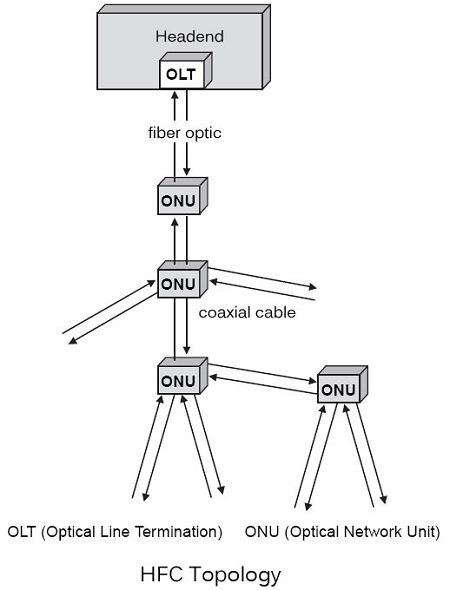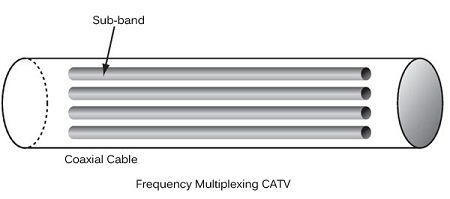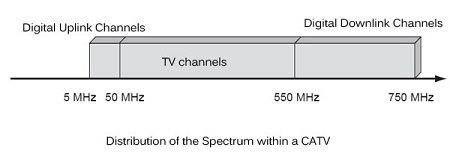Another solution to obtain a broadband distribution network is to use the wiring of cable operators, when it exists. This wiring has long been made of CATV (cable TV), whose bandwidth exceeds 800MHz easily. Today, this infrastructure is slightly modified by the introduction of systems HFC (Hybrid Fiber/Coax), combining a fiber portion between the head end and the beginning of the service by the CATV. This topology is illustrated in Figure.

This solution has many advantages but also some major defects. Its main advantage is the ability to optimize what is transmitted in different channels, since each channel is independent of the other channels. Multimedia is easily supported by assigning a media per sub-band, each sub-band having the opportunity to be optimized. Simply keep the analog information or scanning.
Television channels pass through separate subbands. A specific sub-band can be dedicated to a telephone voice connection and one sub-band to the internet. This Internet access requires the use of a cable modem, which allows access to the sub-band connected to the Internet. This type of modem requires a determined frequency corresponding to the selected sub-band for the Internet connection. Its speed can reach through a high bandwidth several megabits per second.

The distribution of bandwidth between different subbands is illustrated in FIG. The band of 50-550 MHz is reserved for analogue TV channels. Each channel requesting a bandwidth of 6 MHz, it is possible to stream and up to 80 TV channels. Digital television requires a lower bandwidth, allowing to multiply by three or four the number of TV channels carried by the cable.
The band of 5-550 MHz corresponds to channels from the user to the network head. The 550-750 MHz band from the headend to serve the user terminal. It can be used both for telephone speech and Internet connections.
 The weakness of this technique is that the frequency multiplexing is not the best use of bandwidth and does not really allow the integration of different services transiting the CATV. Time multiplexing bring better use of available bandwidth and integrate in a single component access to all the information to the access point. A packet transfer would also represent a suitable solution, provided you completely change the end components.
The weakness of this technique is that the frequency multiplexing is not the best use of bandwidth and does not really allow the integration of different services transiting the CATV. Time multiplexing bring better use of available bandwidth and integrate in a single component access to all the information to the access point. A packet transfer would also represent a suitable solution, provided you completely change the end components.
In summary, a multimedia application can be carried over the coaxial cable of câbloopérateurs but being obliged to consider the transport of media on parallel bands and not on a single band.
HFC is another solution, which is to use fiber optics to allow the network to carry up to a little distance away from the user broadband communications, being relayed by the coaxial cable to the user socket. Due to its very large capacity, the optical fiber can convey as many channels as there are users to be reached, what is unable CATV soon as the number of users becomes large. For the latter, we must find a multiplexing solution upstream channels to the heart string to get to transit all requests from users on the network. This problem is illustrated in figure.

Suppose a channel associated with the Internet connection has a flow rate of 34 Mbit/s, which is now the standard case. If, on a CATV tree 10000 outlets are connected and active, the total throughput on the downlink and the uplink is 3.4 kbit/s per user. To offer a better rate, we must realize statistical multiplexing to recover the bandwidth not used by some users. However, it is obvious that if there are too many simultaneous users, the flow is insufficient.
The following standards have been proposed as access techniques to allow users time multiplexing on a common band:
• MCNS-DOCSIS (Multimedia Cable Network System-Data Over Cable Service Interoperability Specification), used primarily in North America but adopted by some European cable operators.
• IEEE 802.14, which uses ATM technology.
• DVB-DAVIC (Digital Video Broadcasting-Digital Audio Visual Council), which comes an industrial video group.
 Dinesh Thakur holds an B.C.A, MCDBA, MCSD certifications. Dinesh authors the hugely popular
Dinesh Thakur holds an B.C.A, MCDBA, MCSD certifications. Dinesh authors the hugely popular